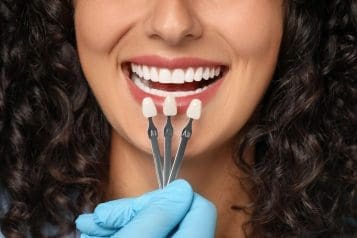 Photo Credit: Jacob Lund/Shutterstock.com
Photo Credit: Jacob Lund/Shutterstock.com
It’s that time of year again: the annual dental check-up. You’re probably over your childhood fear of the dentist at this point, but there’s still one hurdle most can’t get over. The seemingly harmless question is enough to produce sweaty palms and darting eye contact: “So, how often have you been flossing?”
Dentists like Haute Beauty expert Dr. Mimi Yeung of M.Y. Dental Spa in Manhattan ask because they know just how important the practice is. A mainstay of every beauty routine, flossing is integral for both everyday hygiene and long-term health. The most obvious benefit is removing visible food debris from teeth. Anyone who’s led a team meeting after a lunchtime salad knows this one. Flossing also helps prevent bad breath. Of course, brushing teeth regularly is a must, but a toothbrush can’t conquer those harder-to-reach places between teeth. Regular flossing is also key to preventing more serious oral health issues like plaque buildup, which can lead to unhealthy gums and periodontal disease.
 Photo Credit: Alliance Images/Shutterstock.com
Photo Credit: Alliance Images/Shutterstock.com
With all these benefits, why can it be so difficult to maintain a flossing regimen? For many, it’s because of the potential for pain during and after. Flossing can even cause gum bleeding, especially when it’s for the first time in a long time. Fortunately, Dr. Yeung has a few tips for avoiding this block in the road to a beautiful, healthy smile.
- Be gentle. Gum pain is often caused by over-aggressive flossing. Whether you’re out of practice or in a hurry, using too much force is sure to cause soreness. Take your time and be consistent. Over time, gums will become more accustomed to the practice.
- Try a different floss. If being gentle doesn’t help with pain, using a different floss may do the job. Less abrasive floss options with soft coatings offer a gradual transition as gums become accustomed to your new healthy habit.
- Use a water floss machine. Also called a water pick, this device shoots water into the crevasses between teeth to remove food and plaque. Many come with attachments made to reach different parts of the mouth more effectively.
Flossing is easy to overlook, even for the avid tooth-brusher. Many would say it’s tedious at best and agonizing at worst. Despite the downsides, many benefits make it safe to say flossing is worth the pain. And with a bit of troubleshooting and a visit to Dr. Yeung's office, you can reap the rewards without shedding a tear or a drop of blood.
For more information, visit Dr. Mimi Yeung's social media:






















